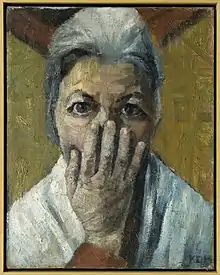Käthe Ephraim Marcus
Käthe Ephraim Marcus (also Kathe Ephraim-Marcus, Kaethe; née Ephraim; b. 1892, Wrocław – d. 1970, Ramat Gan) was a German-Israeli painter and sculptor.

Marcus studied at art schools in Karlsruhe and Wrocław (then Breslau) between 1911 and 1912.[1] In 1913, she studied with Lovis Corinth and Max Beckmann.[1][2]
Her husband Dr. Joseph Marcus (1886-1961) was a senior government official in Breslau and Zionist organizer.[2][3][4] The couple likely met through the hiking group and youth movement "Blau Weiss" in Breslau.[5] They married in 1917.[6]
She met Käthe Kollwitz in 1920 in Berlin and was influenced by her expressionist figuration.[3]
She spent 1925 in Paris at the Académie de la Grande Chaumiere and in the studio of André Lhote.[1] In 1932, an Austrian-Jewish journal printed an article that described her as most famous for her work for children's books, in which she represented the struggle for a child to understand the world in balanced compositions and harmonies of color.[7]
In 1934, she and Joseph emigrated to Palestine after spending 1933 in England.[2][3]
Marcus was evicted from her studio in Jerusalem in 1947 by the British; much of her early work was destroyed.[3] In 1948, she was evacuated to Ramat Gan.[3]
Marcus was the subject of many solo exhibitions and retrospectives during the 1960s to the 1980s.[8] Her art also appeared in large group exhibitions that defined Israeli art in major museums in Tel Aviv and Jerusalem.[8] Marcus's paintings have become part of the canon of Israeli art,[9] and, in particular, of Israeli feminist art.[10] Her art is characterized, in the words of one reviewer, "an atmosphere of melancholy, loneliness and alienation. She often painted subjects of mothers and children, bewildered and lonely women in hostile environments, new immigrants and transit camps."[3]
In 1961, she published a book titled Out of My Life.[4]
She died in 1970 in Ramat Gan, Israel.[1]
References
- "Kathe Ephraim Marcus". Information Center for Israeli Art / The Israel Museum, Jerusalem. Retrieved 2019-12-01.
- Cohn, Willy (2006). Kein Recht, nirgends: Tagebuch vom Untergang des Breslauer Judentums, 1933-1941 (in German). Böhlau Verlag Köln Weimar. pp. 419–420. ISBN 978-3-412-32905-1.
- Markus, Ruth (February 27, 2009). "Artists: Yishuv and Israel: 1920-1970". Jewish Women: A Comprehensive Historical Encyclopedia. Retrieved 2019-12-01.
- Röder, Werner; Strauss, Herbert A.; Schneider, Dieter Marc; Forsyth, Louise (2011-11-10). Politik, Wirtschaft, Öffentliches Leben (in German). Walter de Gruyter. p. 474. ISBN 978-3-11-097028-9.
- Sehlke, Stephan (2009). Pädagogen - Pastoren - Patrioten: Biographisches Handbuch zum Druckgut für Kinder und Jugendliche von Autoren und Illustratoren aus Mecklenburg-Vorpommern von den Anfängen bis einschließlich 1945 (in German). BoD – Books on Demand. p. 244. ISBN 978-3-8370-9497-8.
- "Artists: Yishuv and Israel: 1920-1970 | Jewish Women's Archive". jwa.org. Retrieved 2019-12-01.
- Straus-Ernst, Luis (1932). "Käthe Ephraim Marcus". Menorah: Jüdisches Familienblatt für Wissenschaft (in German). 10/11: 442 – via Austrian Literature Online.
- "Kathe Ephraim Marcus - Exhibitions Page". Israel Museum Information Center for Israeli Art. Retrieved 2019-12-01.
- "1948: The Beginnings of an Israeli canon in the Visual Arts". המשכן לאמנויות. 2015-10-28. Retrieved 2019-12-01.
- Dekel, Tal (2011). "From First-Wave to Third-Wave Feminist Art in Israel: A Quantum Leap". Israel Studies. 16 (1): 149–178. doi:10.2979/isr.2011.16.1.149. ISSN 1084-9513. JSTOR 10.2979/isr.2011.16.1.149. S2CID 143497312.